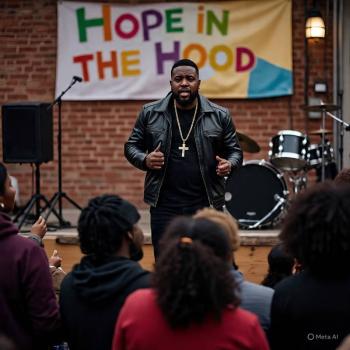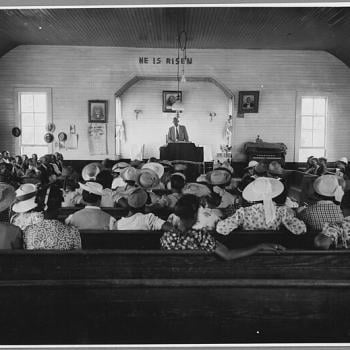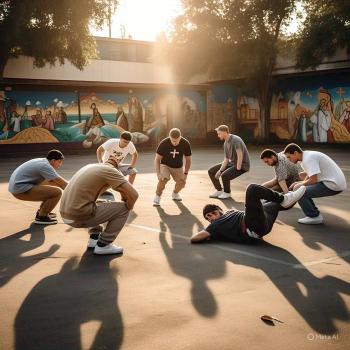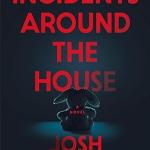There has not been enough attention given to female Christian Hip Hop. To honour all the mothers, this article will feature female Christian rappers, with special attention to how they use the cypher.
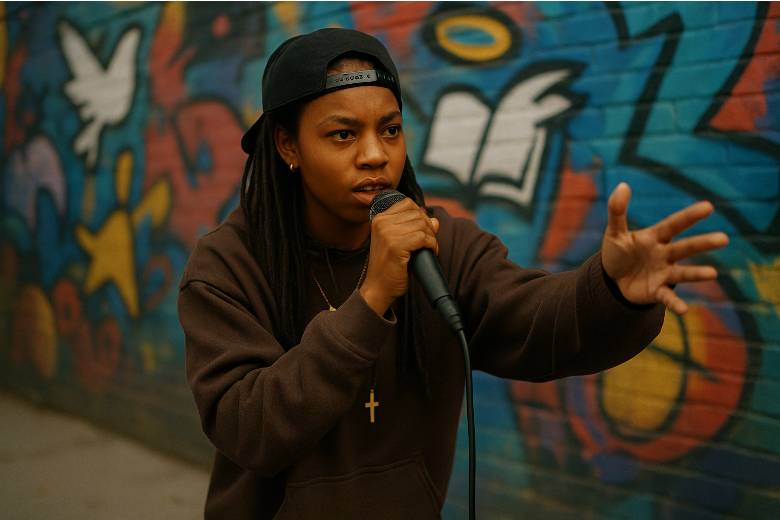
The Power of the Female Image
Going through hours of female Christian Hip Hop, two themes surface. One is the importance that these Hip Hop artists focus on following scripture and its application as a lived experience. The other theme is how the image is used to contest a silent female. There are some Christian Hip Hop artists who extend this second point to flirt with pop culture references (i.e., Myammee).
In her work, “This Is What It Look Like,” Myammee starts by questioning the stereotypical image of a Christian.
The video unfolds, hosting images of choreographed female dancers scantily dressed in a hypersexual style. The opening “Message” read by Myammee, asks if the image of a Christian must be housed in static, plain pages of the bible. Her argument is for a contemporary fashion of the female Christian body. Myammee specifically hypersexualises the female body as a political reading of the female image. Her direct contextualising of the female Christian body as an alluring icon of desire operates to underscore her argument, but equally deflects the intent of her argument. The lyrics fall on deaf ears as Myammee and her entourage promote more of a physical attraction than attention on scripture. The use of slang in the title and throughout the lyrics is to further articulate the relevance of a modern Christian discourse. The complication of the video is that some will miss the juxtaposition that Myammee is working to state. There will be some who focus on the image and not realise the critique of the body is central to the overall theme of the work. Myammee is bold in presenting this work, which is consistent with the body of her work. Myammee is a defined, devout Christian who enjoys high fashion. For her body politic, there is no division for a Christian woman to engage contemporary fashion while engaging a biblically centred life. Myammee’s style, in the broadest use of the term, is one coming from a deep Southern style, which follows her roots being from Florida. Myammee’s critique of non-Christian style is made by her use of popular signifiers of pop culture inverted and narrated through her biblically focused lyrics.
The Cypher, Lady’s Style

How female Christian Hip Hop artists use the cypher speaks across generations. There is a strong lineage to the African American church, gospel music, with a strong preacher’s voice. Those female Christian Hip Hop artists who elect this platform follow the elements of Christian Hip Hop: personal testimony, evangelism, discipleship, and scripture-centred lyrics. The cypher is flattened out from the original circular style. The visual medium defines this posture, but it is used to the advantage of these artists. The forefront profile can be seen as a reference to the preacher/pastor’s podium. The complement of those included in the cypher supports the discipleship and evangelism qualifiers of Christian Hip Hop. Having a strong female voice in Christian Hip Hop positions a different pedagogical approach to sharing the scripture. These female Hip Hop artists work in parallel to their male counterparts. Yet, hearing the depth and tenor of the Christian female voice articulating their viewpoints, engagement, understanding, and application of scripture in a biblically-centred rap adds a layer to the Christian Hip Hop voice that male Christian Hip Hop artists cannot accomplish. The dominance of a male voice, as pastor, teacher, and biblical leader, has the potential to become numb to the voice and importance of the doctrine being shared. A refresher of Christian hip hop expression, the female voice speaks (read: raps) across this monotone. The added use of the cypher, employing different female tenor styles, and approach to the foundational elements of Christian Hip Hop promotes the high value and necessity of female Christian rappers.
The example of “NC Female Christian Hip Hop Cypher,” coming from North Carolina in 2017, immediately captures one’s attention. The use of the male introduction is ruptured by the strong electronic musical landscape supporting powerful lyrics and visuals of the female Christian rappers. To help involve the audience, Tiya Nashe introduces her portion by stating, “I’m not even a rapper, dude.” The inclusion of this phrase draws the common listener to a related position in the work. The phrase highlights an evangelistic point, a personal testimonial, and encourages discipleship. The backdrop to the cypher, a common street scene, flows from the original context of the cypher as a community tool for cultural sharing, storytelling, and relationship building. The work is strong on all fronts and works to contextualise the importance of female Christian Hip Hop.
Starting with a close-up of the feet walking, the “CHH Female Cypher, Part 1 (Porsh Love)” is a disciplined, hard-hitting cypher that embraces contemporary femininity as an expressive platform to convey individual testimony. The complexity with this cypher is the commonality which each female brings forth. Their style speaks to the common nature of Christianity. Their vocal style examines a variety of rap styles. Their lyrics unfold testimony with a strong biblical discipline. The combined cypher frames the core application and use of the cypher: to promote storytelling, build community, and share culture. “CHH” (read: Christian Hip Hop) is built into the name of the track. There is no skirting away from what the intent of this work conveys. The use of a black and white style washes out assumptions, stereotypes and makes the subtle statement that their cypher is clear: it’s as plain and simple as being black and white. There is no distortion in the work. The unnecessary elements are removed. The focus is to be on the voice communicating biblical discipline. As colour is morphed in the final seconds of the video, this magnifies the community connection through evangelistic rap from each of the artists. It’s a subtle touch with a pointed inclusion. Going from a pure black and white situation, one can read this as starting without any direction, existing and surviving in a binary reality. By way of evangelism, as the women qualify “gospel rap,” the listener becomes aware and moves from the limitations of the binary to the complexity of the total Christian community experience. The listener is transposed from a marginalised to an inclusive position. The gentle washing of the colour on the image/video speaks to how one can personally ascend from worldly limitations (a black and white reality) to that of a full, rich life (a colourful living experience in the Word). The work promotes an evangelistic perspective not only in lyrics but also in the use of technology to speak across digital borders.
The “South Carolina #CHH Female Cypher” is a cosmopolitan treat for the cypher. The exploration of multiple rap styles from Jamaican rude boi through roots Bronx styles, this collective “represents.” The trickling electronic piano background loop binds with the clear drum backbeat and growling brass interjections, all lay the foundations for serious biblically-centred, testimonial lyrics. The video itself is not visually stunning, which is the main point. To situate this cypher in a community environment illustrates the communal aspect of discipleship. To start, location is defined and territory is claimed by the announcer, stating the collective is from South Carolina. This is a departure from the other works reviewed. Yet, this is a traditional practice of the cypher to localise the lineage of the artist. What is striking is that the common traits of Southern Hip Hop are not introduced. The expected trap hop style (floating, clear, and rapid delivery lyrics over a highly electronic soundscape) is exchanged for an array of Hip Hop diasporic styles. This, along with the youngest rapper in the mix, an eleven-year-old rapper, separates this work head and shoulders above the rest.
Warrior Women Cypher (2022) is a pure audio track which invites the listener to focus on the lyrics even more than in the other examples. Following in the footsteps of the South Carolina #CHH Female Cypher, this work is the only one to use a language other than English. There is one rapper who mixes Spanish with English throughout their portion. The opening trumpet sound, a la the shofar (Jewish horn trumpet), positions a call-to-arms for the artist. The echoing background sound of the instrument, along with the bare electronic drum backbeat, sonically paints a militaristic portrait. This works well, noting the abundant amount of military movements, wars, and battles described in scripture. The rappers choose words that are aligned with the progression of a military movement. This proud work thrives on a sparse, haunting soundscape and pointed biblically-centred lyrics. Each rapper flows seamlessly from one to the other like a singular continuous narration. Rather than focusing on testimony, this example focuses on scripture and its application in their life. The “Warrior Women Cypher (2022)” is a proud female statement speaking to the importance of women to function in the army of God.
Why Women Christian Hip Hop Artists Can Speak Boldly.
The women use the cypher to educate the community. Dismissing the traditional circle formation of the cypher, these artists articulate the core principles of Christian Hip Hop: personal testimony, evangelism, discipleship, and scripture-centred lyrics. The included videos contextualise the women in a singular location, removed from public view. Troping on the marginality of the female, these artists break this stereotype through their lyrical expressions. The cypher serves as a dialogue for the artists to express and cross-connect through active discipleship. What is refreshing about how female Christian Hip Hop artists use the cypher is their direct, to the point, and without any question, the intent to share scripture knowledge founded on a direct relationship with God. The variety of beats adds to the flavour of each work.
Those artists coming from southern American regions do not fall into the trap of using a Trap Hop style. This is a more digital style with a clear division between the lyrics and the musical landscape. Trap Hop exposes the relationship between the lyrics and a synthetic drum beat. Those female Christian Hip Hop artists from the southern regions of the U.S., rather, continue along an “O.G.” (Original Gangsta) style of roots Hip Hop. This style is juxtaposed with scripture-centred lyrics. Taking such an approach speaks to a large audience base. The active discipleship recognised by way of using such a roots Hip Hop style is potent.
Talk To Me Sista!
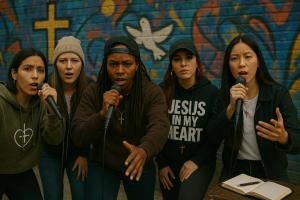
The works presented collect a variety of rap styles. Leaning on the prolific attribute of the female voice, Christian Hip Hop benefits by including these and similar works in the discourse. The approach these female Christian Hip Hop artists demonstrate is the critical pedagogical directive available from a woman’s point of view. The work of female Christian Hip Hop artists is stated to contest or challenge male Christian rappers. The Christian Hip Hop canon is largely composed of male Christian rappers. What female Christian Hip Hop artists bring to the Hip Hop table is the visibility of the female in scripture. It is far too simple for the women’s involvement in biblical doctrine to be eclipsed by the foundational male perspective. It is in Christian Hip Hop where the female voice can work in parallel to their male counterparts. This unification, male and female, articulates the biblical foundation of the world as God planned (Genesis 1:27, Genesis 2:24): one man and one woman working together to build the world and celebrate the creator, God, through active worship in words, thoughts, and action (read: Christian Hip Hop).





